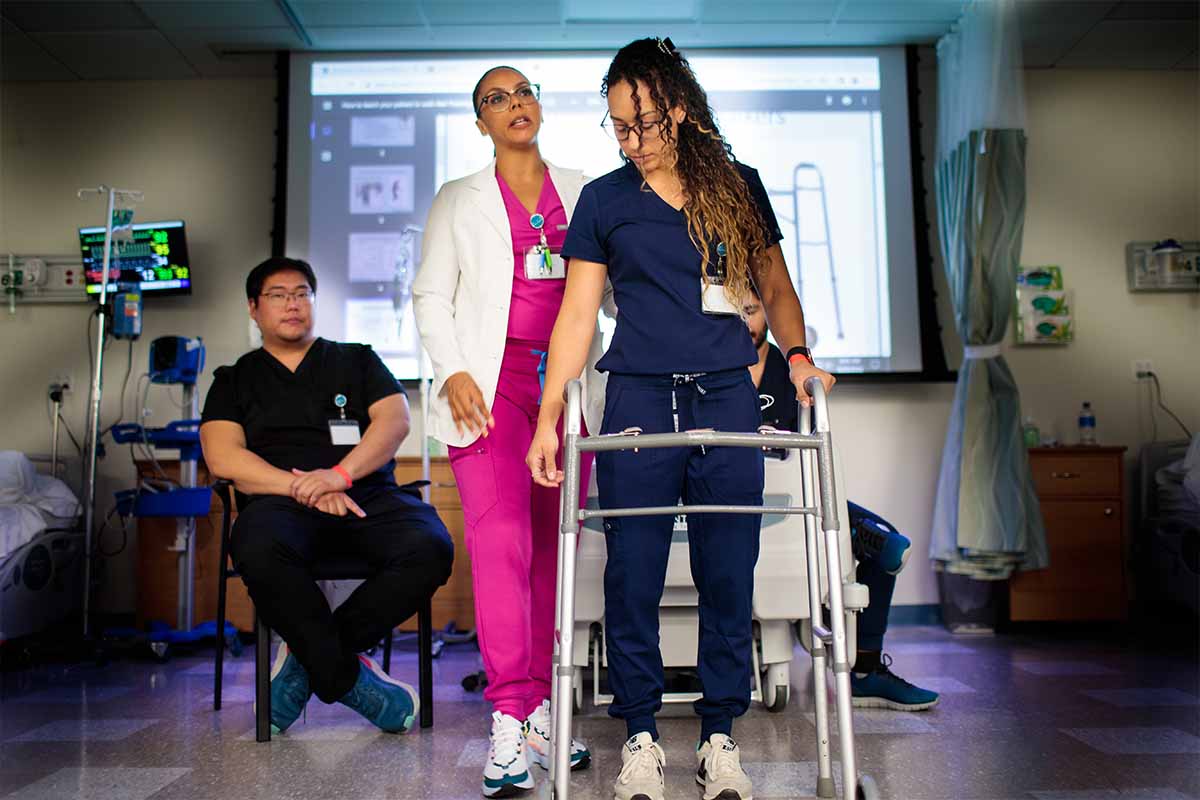
Occupational therapists (OTs) are a vital part of healthcare. From helping an elderly patient relearn skills after a stroke to aiding a professional recover their strength after a workplace injury, OTs provide invaluable support to people of all ages—and can enjoy a rewarding career.
If you’re considering a career as an occupational therapist, you’re likely wondering where your services will be needed—and where your education, training and hard work will pay off the most.
Where Do Occupational Therapists Work?
Occupational therapists offer a range of services to improve patient health and quality of life by empowering them to engage in everyday activities. OTs can specialize in areas such as youth rehabilitation or mental health and assist with a wide spectrum of needs.
OTs can help patients with Alzheimer’s improve their mobility after a fall and support them with guidance to bathe safely and regain independence. They also assist children with developmental delays and help them improve their fine motor skills to enhance their performance at school and in social settings. When it comes to aged care, OTs help elderly patients navigate age-related problems, such as memory loss, vision loss, hearing loss, and poor coordination, all while helping them with daily tasks.
Where do OTs work? Occupational therapists work in a variety of settings, including:
- Hospitals
- Clinics
- Nursing homes
- Rehabilitation centers
- Mental health facilities
- Home health agencies
- Schools
The U.S. Bureau of Labor Statistics (BLS) states that nearly half of occupational therapists work in a hospital setting or an occupational therapy office.1
Where Can Occupational Therapists Work to Fulfill the Highest Demand?
According to the U.S. Bureau of Labor Statistics, the demand for occupational therapists is expected to grow nationwide over the next decade.1 On a state level, however, the BLS also shows that several locations have a high demand for OTs at present.1
Where can occupational therapists work? States with a high concentration of OT jobs include2:
- Connecticut
- Maine
- Massachusetts
- New Hampshire
- Indiana
The need for skilled healthcare practitioners, including occupational therapists, is also rising in rural America.2 This increasing demand impacts 60 million people, or one in five Americans, highlighting the need for OTs in non-urban regions.3


Where Does an Occupational Therapist Work and Earn the Most?
Income can be a determining factor when choosing a state to live and practice. In 2023, the median annual salary for occupational therapists across the nation was $96,370—or $46.33 per hour.1
OT salaries can vary depending on the city and state where an OT lives and works. Keep in mind that purchasing power also plays a role here – cost of living in a certain city can be much higher than in another. And often, it’s higher in a city than in a nonmetropolitan area, which usually results in a higher median salary. But if you’re generally wondering where can OTs work and earn a high income? Discover the top five highest-paying metropolitan areas2, all of which are in California:
| Metropolitan Area | Annual Mean Wage |
| San Jose, Ca. | $134,140 |
| San Francisco, Ca. | $125,850 |
| Santa Rosa, Ca | $124,130 |
| Sacramento, Ca. | $119,900 |
| Modesto, Ca. | $117,130 |
What about the highest-paying states? Where can occupational therapists work to earn the highest income? The states with the highest mean salaries are California, New York, Nevada, New Jersey, and Colorado.2
The setting in which you choose to practice can also impact your salary. Data shows that management of companies and enterprises and home health care services are two of the highest-paying areas.2
What Is the Overall Job Outlook for Occupational Therapists?
The demand for OTs is expected to continue to grow. In 2022, the U.S. Bureau of Labor Statistics predicted that OT jobs will accelerate at a rate of 12% over the next decade.1 Roughly 9,600 occupational therapy roles are projected to open each year.1
Occupational therapy is a booming career field with excellent prospects. Physical therapy (PT) is another excellent option within the health sciences, too. Bureau of Labor Statistics data shows a similarly positive outlook for growth in the field, with job growth projected to accelerate by 15% over the next decade and 13,900 jobs expected to open each year.4


Launch Your Career in Occupational Therapy
Are you ready to pursue a career in occupational therapy? One thing to consider when it comes to how to get into occupational therapy school is picking the right program. The University of St. Augustine for Health Sciences (USAHS) offers collaborative graduate Occupational Therapy (OT) Degree programs.
USAHS offers Master of Occupational Therapy (MOT), Doctor of Occupational Therapy (OTD), and Post-Professional Doctor of Occupational Therapy (PPOTD) programs that provide you with the training and tools you need to make a difference. Our programs are specifically tailored to meet the demands of the modern student, with flexible and hybrid models to align with your needs and schedule.
Request information about our programs today and pave the way for a rewarding role in occupational therapy.


The entry-level occupational therapy master’s degree program at the Dallas, Texas, campus has applied for accreditation and has been granted Candidacy Status by the Accreditation Council for Occupational Therapy Education (ACOTE) of the American Occupational Therapy Association (AOTA), located at 6116 Executive Boulevard, Suite 200, North Bethesda, MD 20852-4929. ACOTE’s telephone number c/o AOTA is (301) 652-AOTA and its web address is www.acoteonline.org. The program must have a preaccreditation review, complete an on-site evaluation and be granted Accreditation Status before its graduates will be eligible to sit for the national certification examination for the occupational therapist administered by the National Board for Certification in Occupational Therapy (NBCOT). After successful completion of this exam, the individual will be an Occupational Therapist, Registered (OTR). In addition, all states require licensure in order to practice; however, state licenses are usually based on the results of the NBCOT Certification Examination. Note that a felony conviction may affect a graduate’s ability to sit for the NBCOT certification examination or attain state licensure.
Students must complete 24 weeks of Level II fieldwork within 24 months following completion of the didactic portion of the program.
Salary data may not reflect starting pay for recent graduates.
Sources:
- Bureau of Labor Statistics, U.S. Department of Labor, “Occupational Therapists,” BLS, April 17, 2024, https://www.bls.gov/ooh/healthcare/occupational-therapists.htm
- Bureau of Labor Statistics, U.S. Department of Labor, “Occupational Employment and Wage Statistics,” BLS, April 3, 2024, https://www.bls.gov/oes/current/oes291122.htm
- America Counts Staff, “One in Five Americans Live in Rural Areas,” US Census Bureau, https://www.census.gov/library/stories/2017/08/rural-america.html
- Bureau of Labor Statistics, U.S. Department of Labor, “Physical Therapists,” BLS, April 17, 2024, https://www.bls.gov/ooh/healthcare/physical-therapists.htm










